| Before I went to the Farne Islands with my camera on the first occasion, I did a bit of research on what to expect, the best equipment to take and tips on taking photographs. It wasn’t easy to find anything that was of real use for me on the Google search other than this link, so, considering the popularity of the place I thought I would give my take on it from my experiences in the years since. I will say up front that, if you live in the UK, are interested in nature, wildlife or birds then this or one of the other similar places such as this, Bass Rock, Skomer, etc., is a must. They are just one of those few, special places where you are so close to such a mass of wildlife, where your sensors are almost overloaded by the sights and sounds of the wildlife around you. It’s now become a yearly thing for me to visit the Farnes and is still as spectacular to me on every visit. |
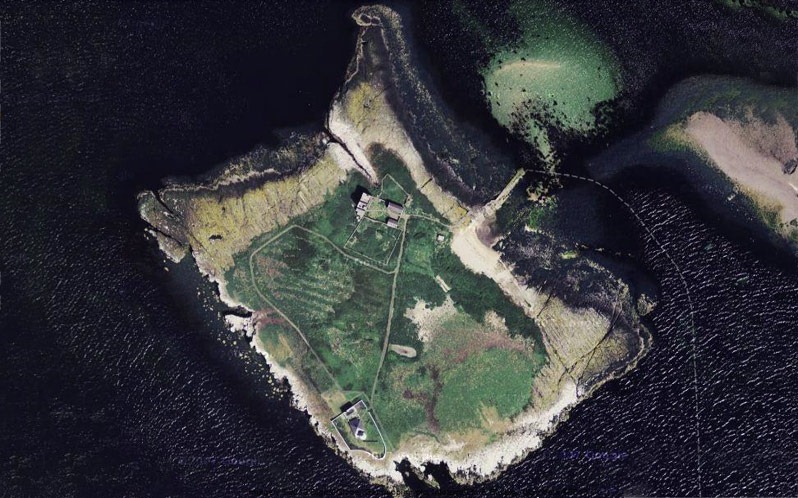 Inner Farne |
| The journey starts at Seahouse, a small seaside town off the coast of Northumberland. You basically have the choices of a cruise to Inner Farne, Staple Island or the all day Island/cruise. It is the former where my experiences are from, which is a tour taking around two and half hours including an hour on what is the main bird colony of Inner Farne. For more information on times, dates, etc., I’ve included useful links below, but I’ve always made a point of going around the last week of June when the chicks have hatched and the parents are busy bringing in food for them. It’s also the most likely time for a decent spell of weather which, from a photography point of view, is important. Apart from getting a day of bright, dry weather, I check the offshore winds as, if it is too rough, the boat will not land on the island and this decision may not be made until your already on the boat. There are a number of boat tour guides to choose from of which I have used two. I don’t think you’d be unhappy with any of them though I did like the last trip on the Serenity II boat which was a bit larger than the previous boats taken. The trip lengths and what you see are the same for the Inner Farne trips. |
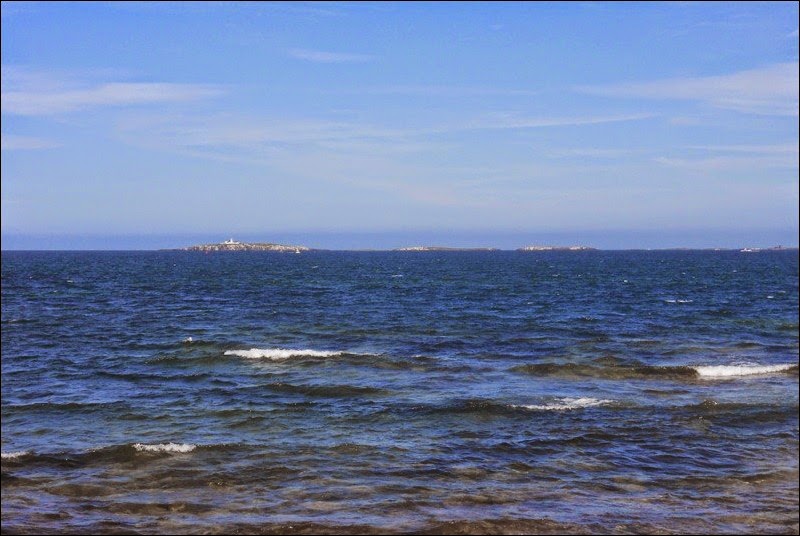 The Farne Islands seen from the mainland starting point at Seahouses |
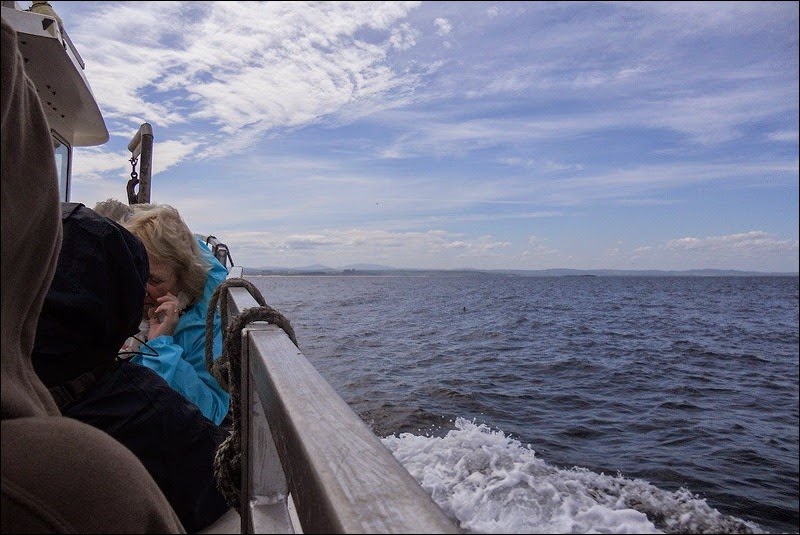 On the boat with the mainland in the background |
Getting ThereThe trip there and back takes up most of the time, though the return trip is a direct route the outward journey spends some time around the other islands, giving you some information about the history and getting you close to cliff edges of nesting birds or to were the seals are. I’m not sure how long the direct trip to the island was but I guess around twenty minutes. It’s a shame they don’t do just the boat trip straight there and back, although the tour around the island and the information supplied while there is interesting, after returning to the Farnes three or four times, there’s not really much point and the time for me would be better spent on the island itself. Depending on how crowded the boat and sea conditions, it would be worth having your camera at the ready as you approach the islands. It’s not long into the journey that you start seeing the many birds from the islands flying around or on the water including the Puffins, giving good photographic opportunities. There’s also the seals and various birds on the islands themselves as you go close by. |
 One of the many seals that can be seen from the boat tour |
 Guillemots on the island cliff edges taken from the boat |
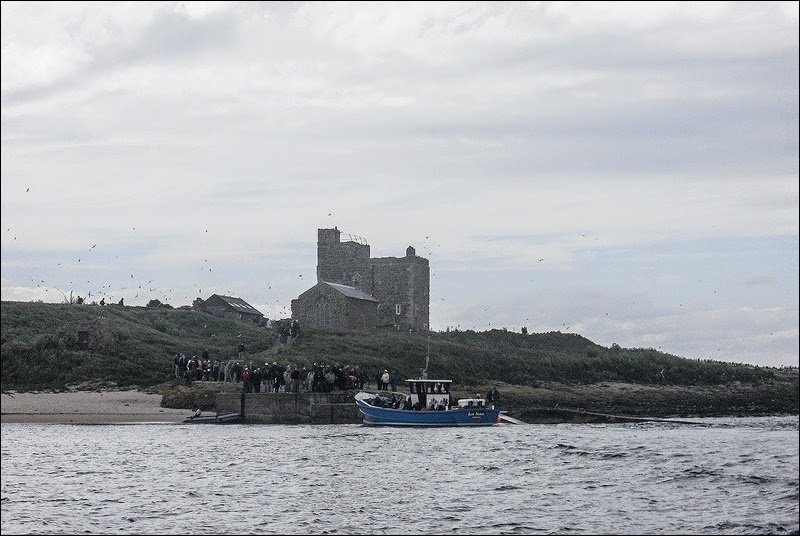 One of the boats offloading/collecting visitors |
The IslandOn landing on the island you have to pay a small fee to the National Trust, from there you walk up through nesting Terns which seem to take great delight at attacking you. I say taking delight because you would think they would be used to the daily trundle of hundreds of visitors passing by. You are walking right by their nests mind you – a foot away from their chicks in some cases and the parents themselves will stop on the poles for you to photograph if you don’t mind their friends attacking you from above at the same time. This first experience is an amazing sight and sound in itself and almost worth the visit itself. I would recommend wearing some kind of hat as they will peck at your head. Although you can get some good images of the Terns on the ground or poles, I’ve put a wide angle zoom lens on my camera, manually set the focus (one metre) and simply pointed that up at them when moving through the barrage, shooting at a quick frame rate. |
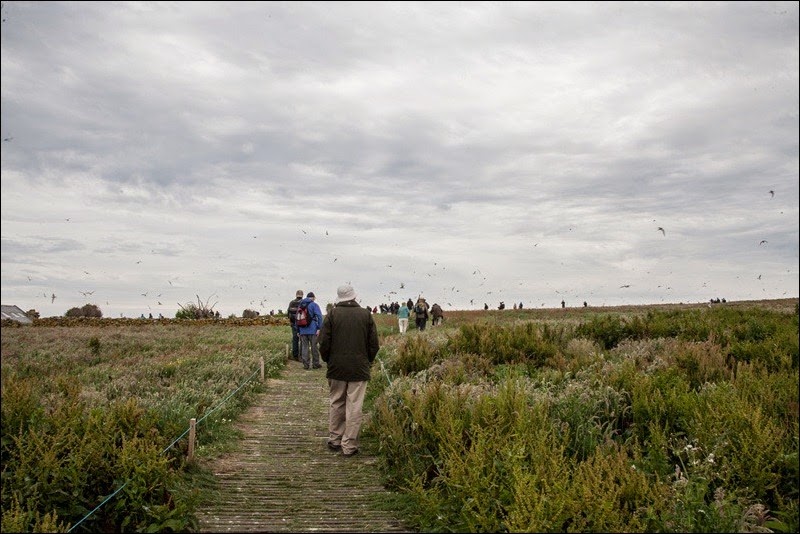 Passing through the gauntlet of the Tern colony |
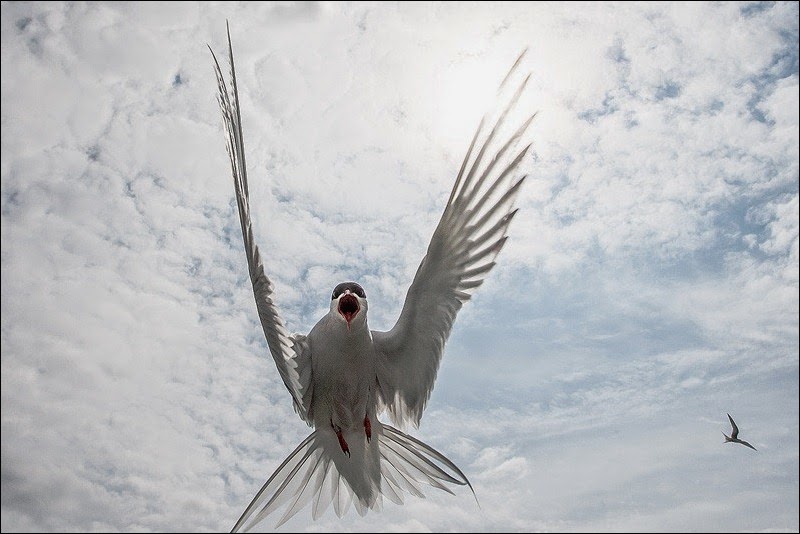 Angry Tern getting a bit close Taken @ 40mm f13, 1/2500, ISO 400 |
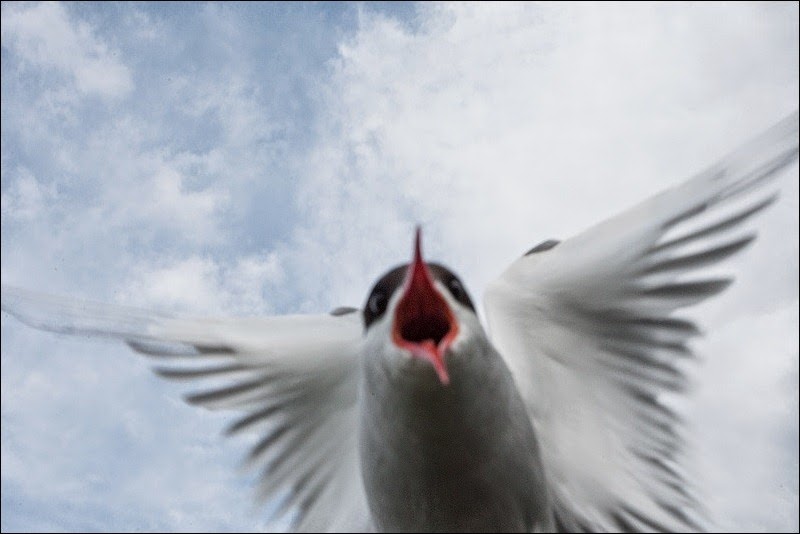 Getting way too close! |
Walking AroundIf you look at the satellite map at the top you can see there is a path that covers half the island. This is the route you can take. The first time I went I followed this all the way around and if you follow this clockwise as you come up from the jetty, there are places you can see much of the various birds and get quite close to such as the Guillemots of which I was able to get some quite close up shots using just a 28-105mm lens. Sometimes, at any new location, the best thing you can do is just stop and look around. Watch what is happening. This is particularly useful for the next part, the Puffins. |
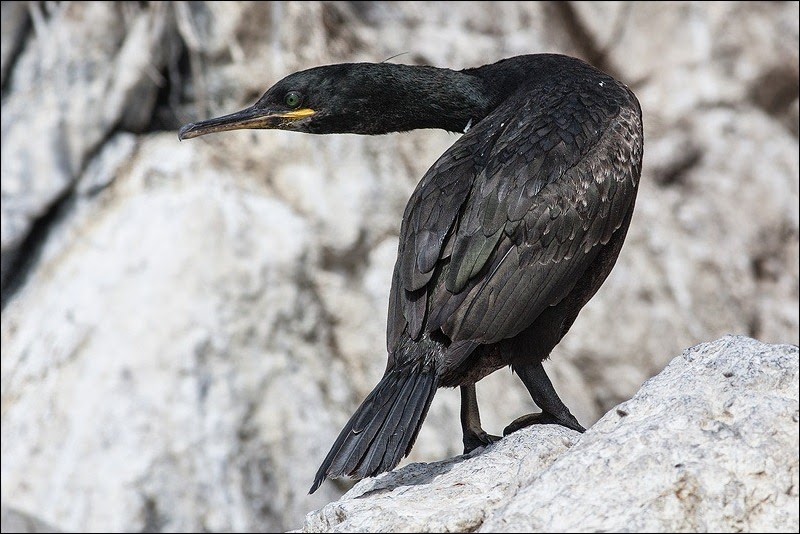 Shag, one of the many on the cliff tops Taken @ 400mm f8, 1/1000, ISO 400 |
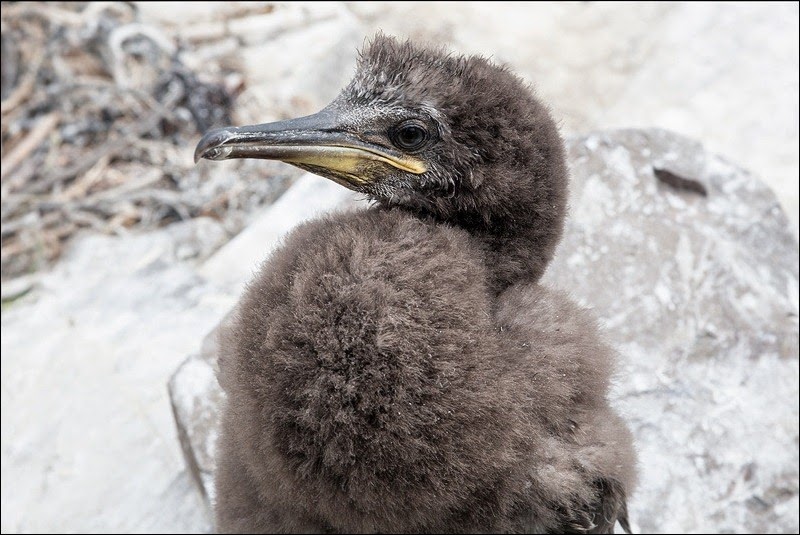 Approachable a Shag chick Taken @ 105mm f14, 1/125, ISO 400, +0.3 Exposure compensation |
The PuffinsFor me, the most interesting part of the island is on the north west area, which is were most of the Puffin action is taking place. Here, the Puffins fly in from the see to there nest burrows on the island as well as further inland, so you get some great opportunities for both close up shots on the ground but also as they fly past or overhead and by close I mean they are within metres of you! What I have found though, is those bringing food back to their burrows fly, literally, straight into their nest burrows. This is because all around are gulls looking for free meal and will ‘mug’ the Puffins if it doesn’t get down into the burrows quick enough. It’s hard not to feel sorry for them. There they are doing all that hard work of getting the meal, only to be robbed by a gull, but that’s nature I guess. It’s difficult then to get that classic pose of a Puffin with Sand Eels in its mouth as they don’t tend to stand around long enough, however, I did notice on the cliffs they don’t have this harassment but are further away so you might need quite a long lens, unlike the ones by the path which you could get good close ups even with a lens with a reach of 300mm. |
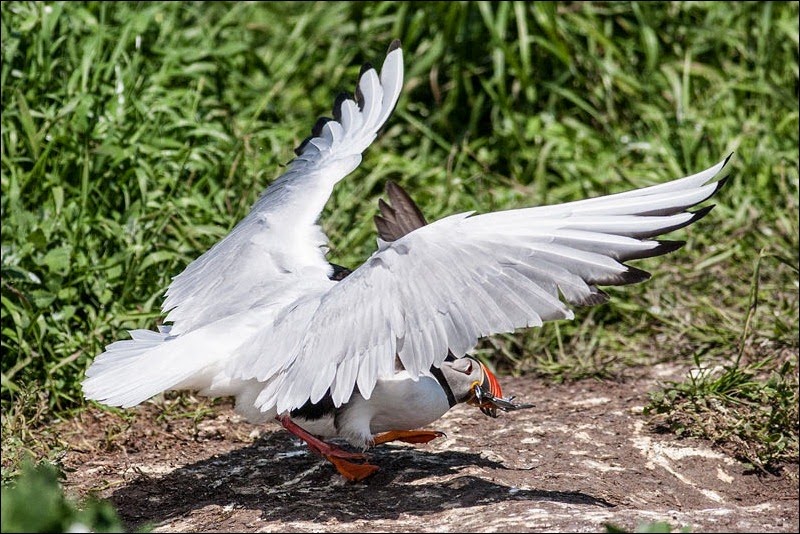 Puffin being ‘mugged by one of the many gulls |
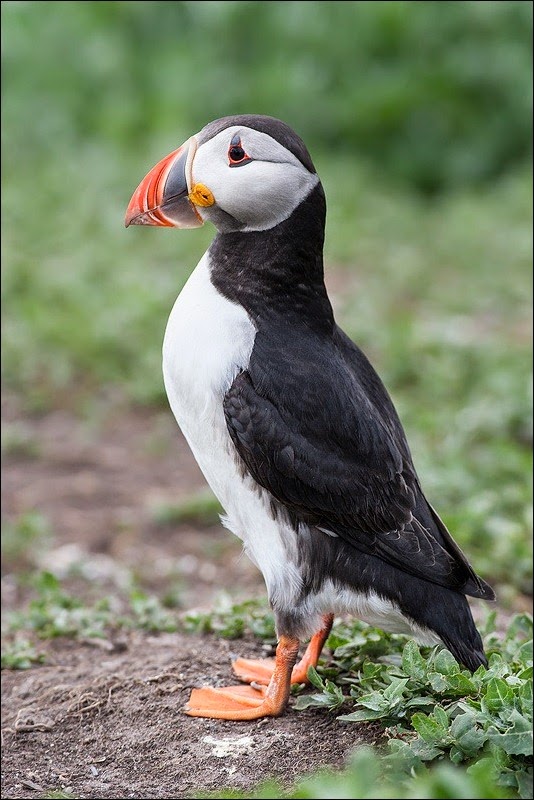 Sides on view portrait Taken @ 400mm f6.3, 1/400, ISO 400 |
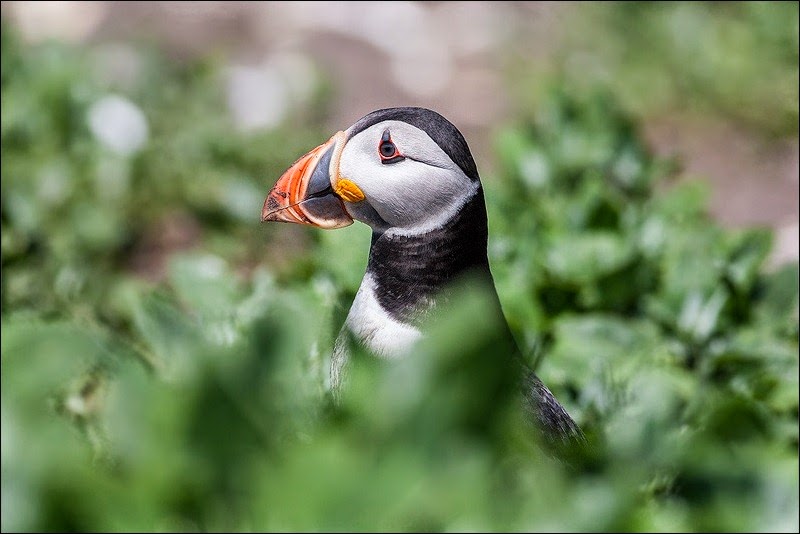 Taken @ 400mm f5.6, 1/2000, ISO 400 |
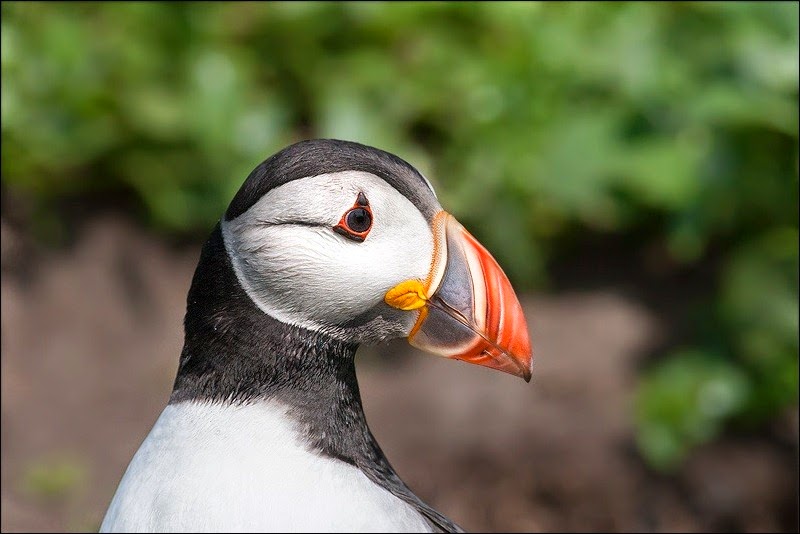 Taken @ 400mm f9, 1/3200, ISO 800 |
The PhotographThe Farne Islands are certainly popular with visitors and most of those you see seem to have a camera of some sort, not surprisingly. What I do find surprising is those who lump over their 500mm, 600mm or even 800mm lenses, along with tripods, gimbal heads etc., it’s complete overkill in my mind. Camera EquipmentUltimately, this comes down to what you have and personal choice. The most obvious thing you notice when you are there is that the birds are all around you, you’re not in some wild expanse trying to stalk timid wildlife. If you are trying to photograph the birds flying around, there’s no getting away from the fact you will need a good fast lens and camera, so ultimately a DSLR system. For anyone who has never seen a Puffin, they’re smaller than you might expect and quite fast flyers so tracking them in flight is a challenge in itself never mind keeping them in focus. If you want to photograph them on the ground, filling the frame then any camera with an equivalent focal length of ideally a minimum of 300mm is possible, though you could get away with less as they do come close to the path. On my last visit, out of curiosity, I did take my 500mm lens and it turned out to be my least productive photo shoots there although ironically, I did take the only ‘classic’ pose with it which I couldn’t have otherwise done. The 500mm was ok for stationary birds, but mobility was a problem for those in flight. The Puffins came in from the see and came in very quickly so would be past or over head before you new it. The view you have in the viewfinder with a 500mm lens attached gives a very small viewpoint which increases the difficulty. Besides, if the bird is going to fly close to you anyway, why bother with a longer lens? I think the ideal lens would be a fast zoom, hand held, which went up to 300 to 400mm. Nearly all my best images of Puffins in flight were taken with a Canon 400mm f5.6 and 1d Mk III. Not having an image stabilizer is not a disadvantage as you need a fast shutter speed to freeze movement, plus IS can slow down the process a bit. The WeatherJust a quick mention on this as it will have an impact if you are taking photographs. Bright sunshine is ideal – blue sky backdrops, bringing out the colours and always helps to give the image a 3d look. It also means you can set the lowest camera ISO for the best quality image. The downside, if the sun is coming from the wrong direction it can cause silhouettes, harsh lighting and, with seabirds that are mostly black or white, exposure problems. |
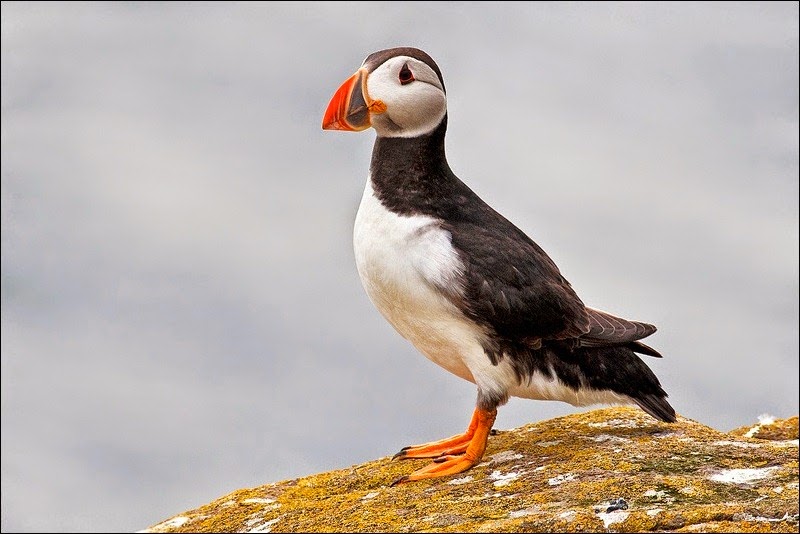 Taken @ 400mm f7.1, 1/1250, ISO 400 |
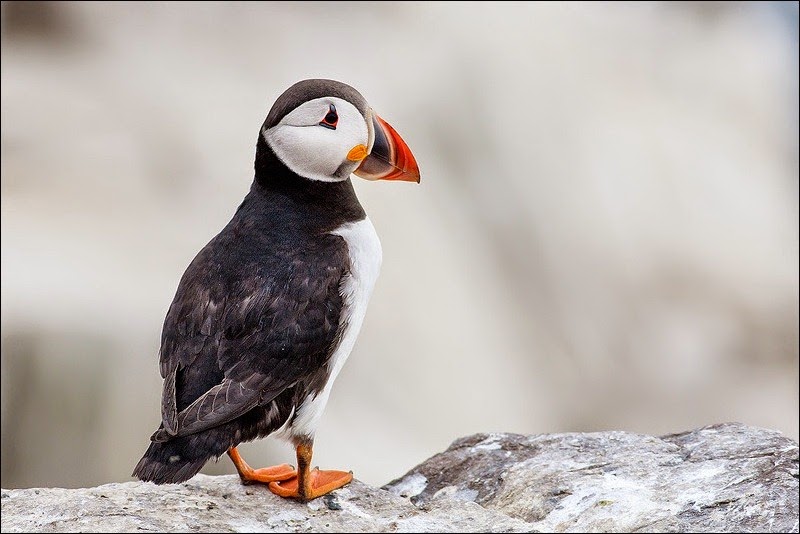 More relaxed – Puffin on the cliffs Taken @ 400mm f6.3, 1/1600, ISO 400 |
The Camera SettingsOne useful feature I do not have on my camera is auto ISO. Depending on the weather and where you are pointing your camera (ground, sea or sky) the light changes dramatically. I would always prefer to keep the ISO down, but at the end of the day what’s the point in having a nice clean, noiseless image if it’s blurred? Despite shooting around 1:00pm in the middle of summer I had my ISO set at between 400 and 800. This wasn’t just so that I could get a shutter speed of 1/1000 or more but so I could close down the aperture as much as possible which, in doing so, will give a greater depth of field. Photographing a bird in flight, you typically want the birds eyes in focus but there’s no guarantee the cameras focus point will be on that so the greater the depth of field the better the chance of the bird all being in focus. I’ve experimented with the different types of metering options and have found that Evaluative or Partial metering the most successful with the occasional + compensation for those in flight shots on an overcast day and possibly - on a bright day due to the white areas of the Puffins plumage. |
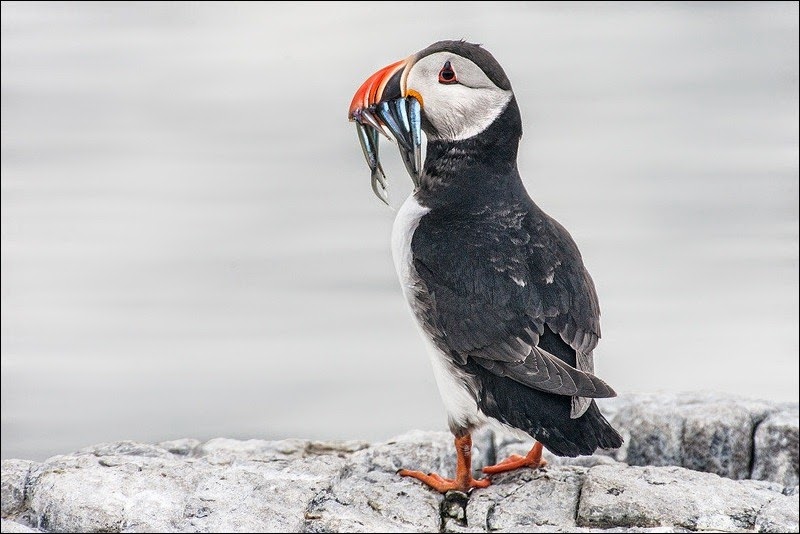 Classic pose Taken @ 500mm + x1.4 converter, f7.1, 1/1250, ISO 800, +.0.7 Exposure compensation |
Examples of fly over opportunities available |
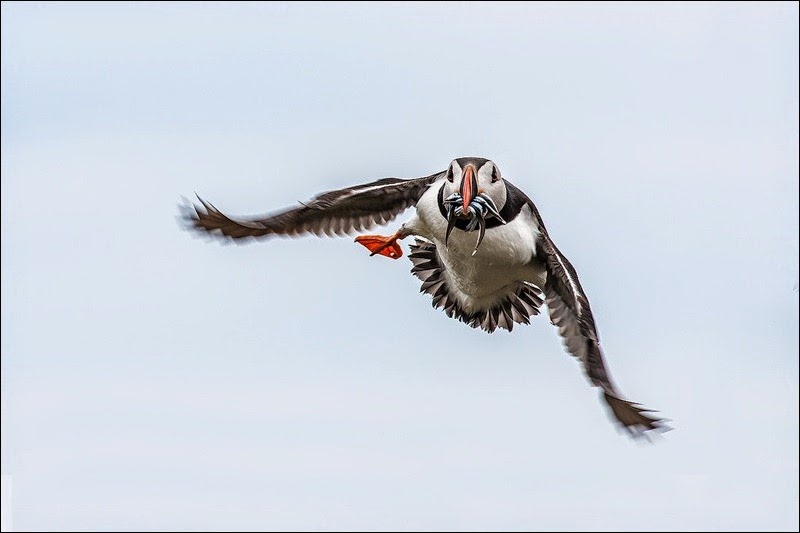 Taken @ 400mm f8, 1/1000, ISO 400, +1.3 Exposure compensation |
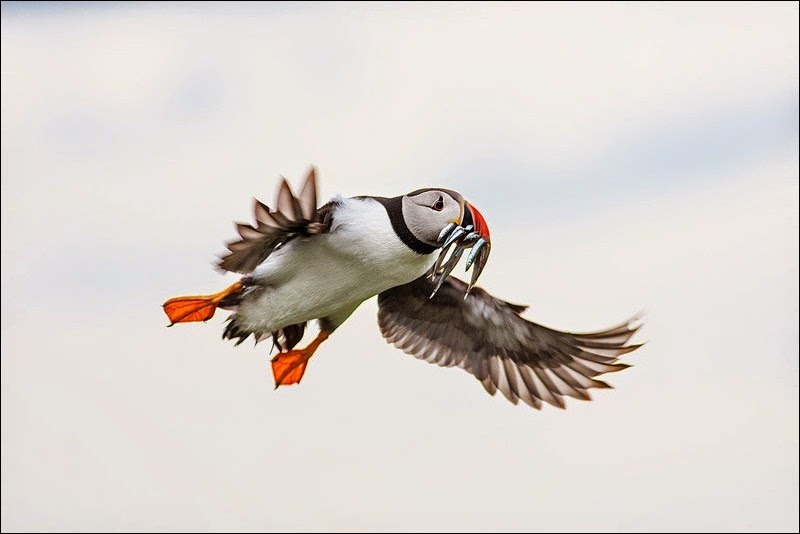 Taken @ 400mm f6.3, 1/1250, ISO 400, +1.3 Exposure compensation |
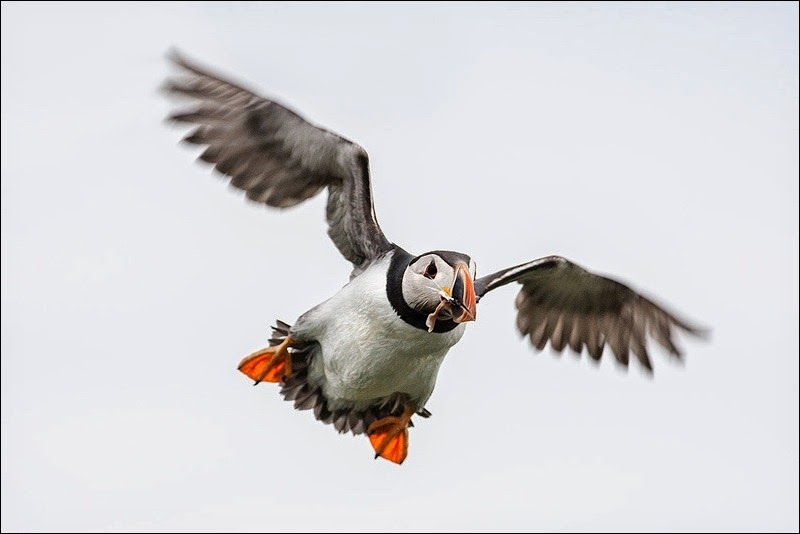 Taken @ 400mm f6.3, /1600, ISO 400, +1.3 Exposure compensation |
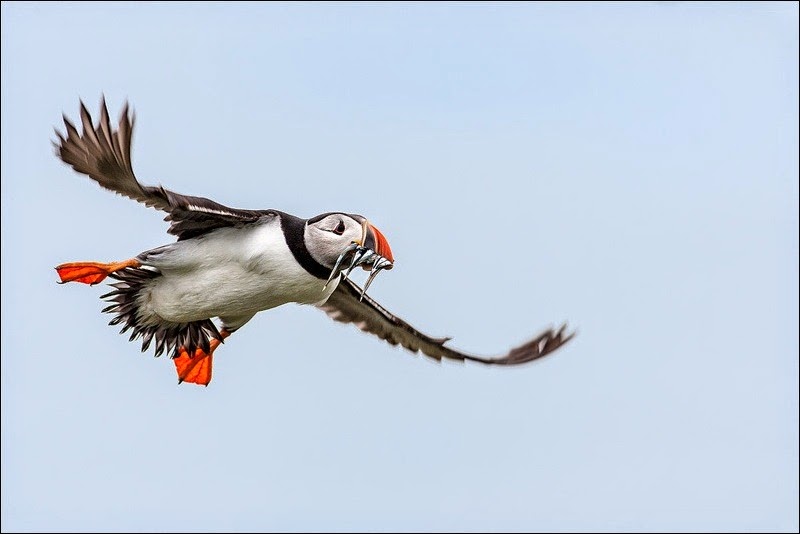 Taken @ 400mm f6.3, 1/1250, ISO 400, +1.3 Exposure compensation |
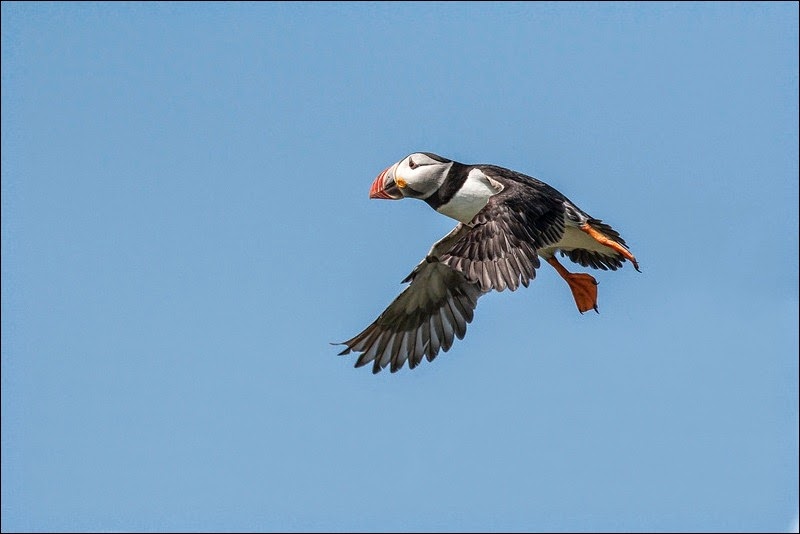 Taken @ 400mm f9, 1/4000, ISO 800 |
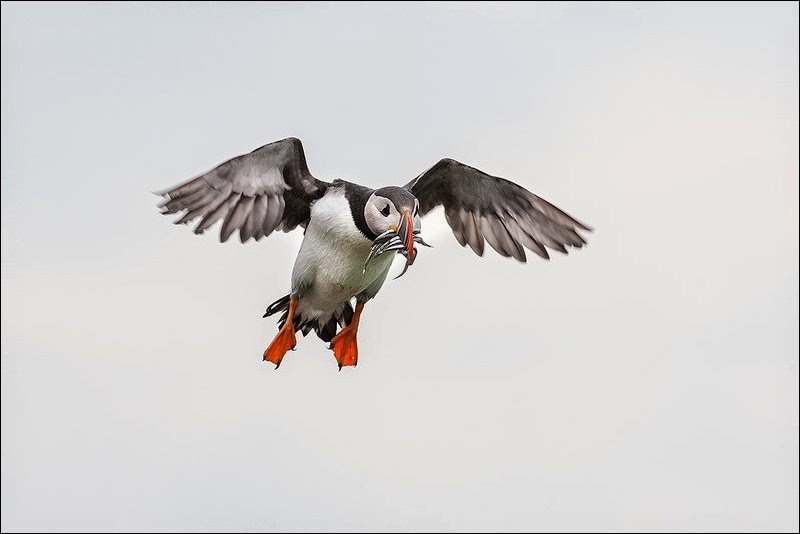 Coming in to land Taken @ 400mm f7.1, /1600, ISO 400, +1 Exposure compensation |
 Coming in off the sea Taken @ 400mm f9, 1/4000, ISO 800 |
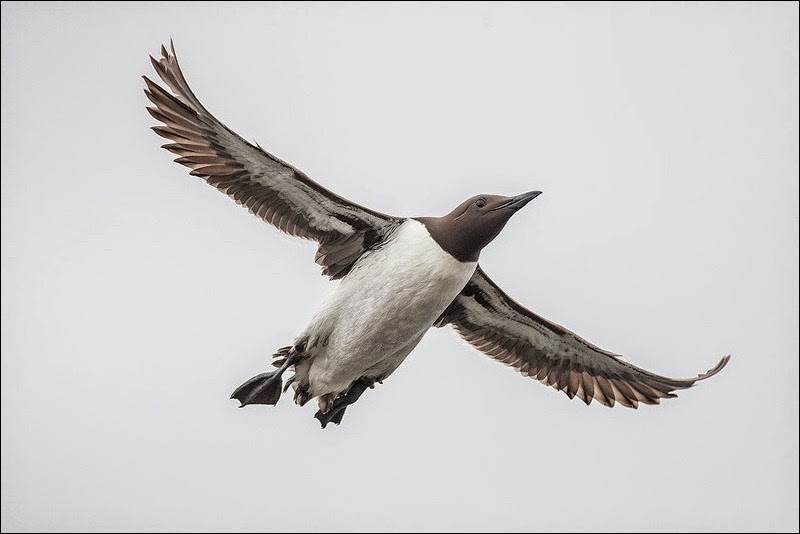 Taken @ 500mm f4.5, 1 /4000, ISO 800, +1.3 Exposure compensation |
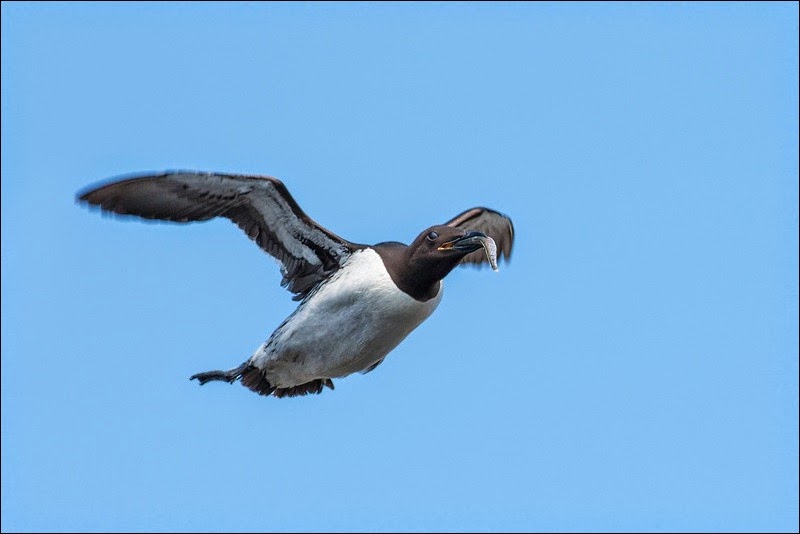 Taken @ 400mm f9, 1/1000, ISO 400 |
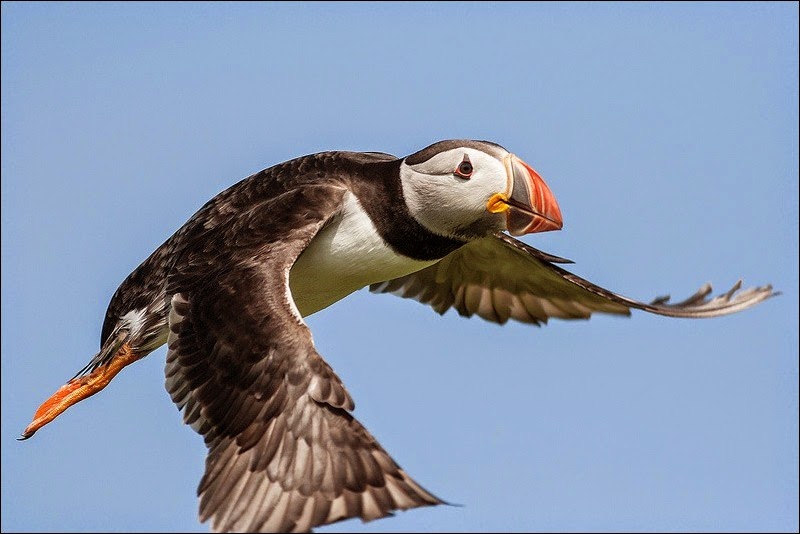 Sometimes they can get too close resulting in clipping, in this case the wing |
| Before you know it your time will be up. Although you have an hour on the island, you have to take into consideration getting back to the boat and walking around the island. It’s amazing how quickly an hour will pass when you’re there. Other Things to BringApart from the camera and lenses a hat would be recommended for the inevitable Tern pecking you will receive and also because that’s not the only defence mechanism they have at there disposal! A waterproof jacket – although I’ve been on the boat when it has been completely calm, I’ve also experienced the spray coming over and soaking everyone. The back of the boat might be the best place to avoid this. You could bring binoculars but you are close enough to see most of the action. |
Useful LinksMy own visits A Long short Farne Island trip A image search for ‘Puffins’ or ‘Farne Islands’ will bring some good images giving you and idea of what to expect. http://www.nationaltrust.org.uk/farne-islands/http://www.farne-islands.com/ http://www.farneislandstours.co.uk/ http://www.wildsight.co.uk/articles/finr.html |
Subscribe to:
Posts (Atom)





Gorgeous photos!
ReplyDeleteThanks for your comment Linda. You can't really go wrong photographically in such an amazing place.
ReplyDeleteVery useful information. Thank you for posting. I will be doing the 2 island trip on Sunday weather permitting and plan to take a D7200 with 300mm f2.8, a D7000 with 105mm f2.8 and a 1.4TC to extend the 105 to 147 and the 300 to 420 if needed. Hopefully I wont need the TC.
ReplyDeleteYour kit should be a good combination especially the D7200 & 300mm combo. You'll probably find the 1.4TC useful for the birds on the cliffs. If you have a wider lens I would take that for the close encounters with the terns. I've never been in May so don't know what to expect but hope to be going in about four weeks time where I'll be back to using my 400mm - the 500mm was too long for me. If you like wildlife, especially birds, this will be a great experience.
ReplyDeleteThank you so much for the information and wonderful photos. I'm from the U.S. and have friends near Berwick upon Tweed within walking distance of the North Sea. We spent two weeks with them in September and developed some familiarity with the area. I would like very much to return and photograph Puffins. I shoot with a Canon 7d MKII and in close-in situations with a lot of bird activity have had good success with my light weight Canon 5.6 400 mm prime lens. What concerns me is the short length of time that you are given on the island in the cruise that you described. Are there other options that allow you to spend more time with the birds?
ReplyDeleteGlad the information is useful for you Jim. I lived in Berwick for a while and it's a good jumping off point to get to Seahouses where the Farnes are, better than where I live in Tyneside.
DeleteYou're right about the short time you have on the Island. An hour isn't enough. It's not even that if you allow for 10 minutes to and from the boat. There's so much happening, birds flying everywhere you look that you really need to stop and look around you particularly when photographing the Puffins, to see the best locations and where they are coming from, landing, behaviour, etc,.
The good news is that there are other trips available including a day trip. I believe this goes to two of the islands, spending around two hours on each. I think all the boat services offer this. Try this link http://farneislandstours.co.uk/our-tours/ for a better idea.
You've got the ideal camera set up in the 7d MkII and 400 5.6mm. If you have a wide angle lens, take that for the Terns. Put it on your camera when you leave the boat set it to the smallest aperture for the greatest depth of field and the fastest shutter speed, set it to focus at around a metre or less add a bit of exposure compensation for the bright sky, then walk through the mass of Terns as they fly at you, with your camera pointing up and rattle off a load of frames and hopefully you will get a few good ones.
One last thought. As you might be in the Berwick area have you thought about a visit to Bass Rock, North Berwick? I haven't been myself so I'm not familiar but they have. I'm not sure about Puffins but they have loads of Gannets, a bird I really want to photograph. There's this link about it https://www.seabird.org/book/boat-trips/16/54